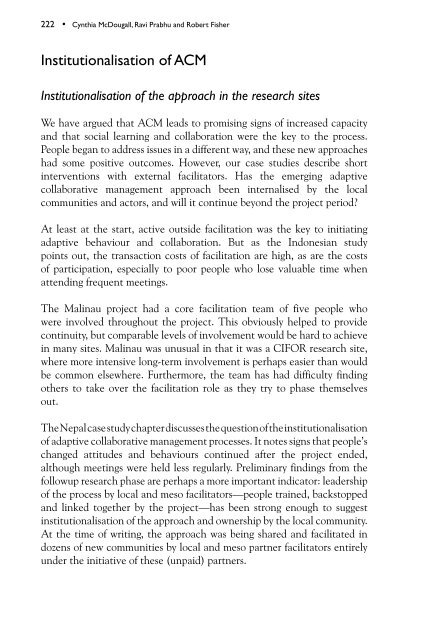Adaptive collaborative management of community forests in Asia ...
Adaptive collaborative management of community forests in Asia ...
Adaptive collaborative management of community forests in Asia ...
You also want an ePaper? Increase the reach of your titles
YUMPU automatically turns print PDFs into web optimized ePapers that Google loves.
222 • Cynthia McDougall, Ravi Prabhu and Robert Fisher<br />
Institutionalisation <strong>of</strong> ACM<br />
Institutionalisation <strong>of</strong> the approach <strong>in</strong> the research sites<br />
We have argued that ACM leads to promis<strong>in</strong>g signs <strong>of</strong> <strong>in</strong>creased capacity<br />
and that social learn<strong>in</strong>g and collaboration were the key to the process.<br />
People began to address issues <strong>in</strong> a different way, and these new approaches<br />
had some positive outcomes. However, our case studies describe short<br />
<strong>in</strong>terventions with external facilitators. Has the emerg<strong>in</strong>g adaptive<br />
<strong>collaborative</strong> <strong>management</strong> approach been <strong>in</strong>ternalised by the local<br />
communities and actors, and will it cont<strong>in</strong>ue beyond the project period?<br />
At least at the start, active outside facilitation was the key to <strong>in</strong>itiat<strong>in</strong>g<br />
adaptive behaviour and collaboration. But as the Indonesian study<br />
po<strong>in</strong>ts out, the transaction costs <strong>of</strong> facilitation are high, as are the costs<br />
<strong>of</strong> participation, especially to poor people who lose valuable time when<br />
attend<strong>in</strong>g frequent meet<strong>in</strong>gs.<br />
The Mal<strong>in</strong>au project had a core facilitation team <strong>of</strong> five people who<br />
were <strong>in</strong>volved throughout the project. This obviously helped to provide<br />
cont<strong>in</strong>uity, but comparable levels <strong>of</strong> <strong>in</strong>volvement would be hard to achieve<br />
<strong>in</strong> many sites. Mal<strong>in</strong>au was unusual <strong>in</strong> that it was a CIFOR research site,<br />
where more <strong>in</strong>tensive long-term <strong>in</strong>volvement is perhaps easier than would<br />
be common elsewhere. Furthermore, the team has had difficulty f<strong>in</strong>d<strong>in</strong>g<br />
others to take over the facilitation role as they try to phase themselves<br />
out.<br />
The Nepal case study chapter discusses the question <strong>of</strong> the <strong>in</strong>stitutionalisation<br />
<strong>of</strong> adaptive <strong>collaborative</strong> <strong>management</strong> processes. It notes signs that people’s<br />
changed attitudes and behaviours cont<strong>in</strong>ued after the project ended,<br />
although meet<strong>in</strong>gs were held less regularly. Prelim<strong>in</strong>ary f<strong>in</strong>d<strong>in</strong>gs from the<br />
followup research phase are perhaps a more important <strong>in</strong>dicator: leadership<br />
<strong>of</strong> the process by local and meso facilitators—people tra<strong>in</strong>ed, backstopped<br />
and l<strong>in</strong>ked together by the project—has been strong enough to suggest<br />
<strong>in</strong>stitutionalisation <strong>of</strong> the approach and ownership by the local <strong>community</strong>.<br />
At the time <strong>of</strong> writ<strong>in</strong>g, the approach was be<strong>in</strong>g shared and facilitated <strong>in</strong><br />
dozens <strong>of</strong> new communities by local and meso partner facilitators entirely<br />
under the <strong>in</strong>itiative <strong>of</strong> these (unpaid) partners.
















